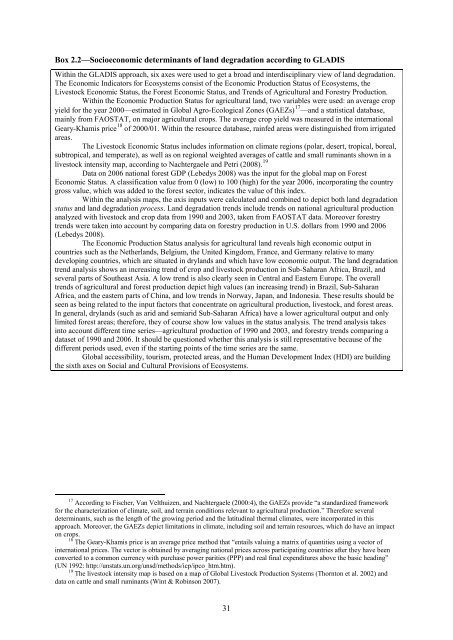The Economics of Desertification, Land Degradation, and Drought
The Economics of Desertification, Land Degradation, and Drought
The Economics of Desertification, Land Degradation, and Drought
Create successful ePaper yourself
Turn your PDF publications into a flip-book with our unique Google optimized e-Paper software.
Box 2.2—Socioeconomic determinants <strong>of</strong> l<strong>and</strong> degradation according to GLADIS<br />
Within the GLADIS approach, six axes were used to get a broad <strong>and</strong> interdisciplinary view <strong>of</strong> l<strong>and</strong> degradation.<br />
<strong>The</strong> Economic Indicators for Ecosystems consist <strong>of</strong> the Economic Production Status <strong>of</strong> Ecosystems, the<br />
Livestock Economic Status, the Forest Economic Status, <strong>and</strong> Trends <strong>of</strong> Agricultural <strong>and</strong> Forestry Production.<br />
Within the Economic Production Status for agricultural l<strong>and</strong>, two variables were used: an average crop<br />
yield for the year 2000—estimated in Global Agro-Ecological Zones (GAEZs) 17 —<strong>and</strong> a statistical database,<br />
mainly from FAOSTAT, on major agricultural crops. <strong>The</strong> average crop yield was measured in the international<br />
Geary-Khamis price 18 <strong>of</strong> 2000/01. Within the resource database, rainfed areas were distinguished from irrigated<br />
areas.<br />
<strong>The</strong> Livestock Economic Status includes information on climate regions (polar, desert, tropical, boreal,<br />
subtropical, <strong>and</strong> temperate), as well as on regional weighted averages <strong>of</strong> cattle <strong>and</strong> small ruminants shown in a<br />
livestock intensity map, according to Nachtergaele <strong>and</strong> Petri (2008). 19<br />
Data on 2006 national forest GDP (Lebedys 2008) was the input for the global map on Forest<br />
Economic Status. A classification value from 0 (low) to 100 (high) for the year 2006, incorporating the country<br />
gross value, which was added to the forest sector, indicates the value <strong>of</strong> this index.<br />
Within the analysis maps, the axis inputs were calculated <strong>and</strong> combined to depict both l<strong>and</strong> degradation<br />
status <strong>and</strong> l<strong>and</strong> degradation process. <strong>L<strong>and</strong></strong> degradation trends include trends on national agricultural production<br />
analyzed with livestock <strong>and</strong> crop data from 1990 <strong>and</strong> 2003, taken from FAOSTAT data. Moreover forestry<br />
trends were taken into account by comparing data on forestry production in U.S. dollars from 1990 <strong>and</strong> 2006<br />
(Lebedys 2008).<br />
<strong>The</strong> Economic Production Status analysis for agricultural l<strong>and</strong> reveals high economic output in<br />
countries such as the Netherl<strong>and</strong>s, Belgium, the United Kingdom, France, <strong>and</strong> Germany relative to many<br />
developing countries, which are situated in dryl<strong>and</strong>s <strong>and</strong> which have low economic output. <strong>The</strong> l<strong>and</strong> degradation<br />
trend analysis shows an increasing trend <strong>of</strong> crop <strong>and</strong> livestock production in Sub-Saharan Africa, Brazil, <strong>and</strong><br />
several parts <strong>of</strong> Southeast Asia. A low trend is also clearly seen in Central <strong>and</strong> Eastern Europe. <strong>The</strong> overall<br />
trends <strong>of</strong> agricultural <strong>and</strong> forest production depict high values (an increasing trend) in Brazil, Sub-Saharan<br />
Africa, <strong>and</strong> the eastern parts <strong>of</strong> China, <strong>and</strong> low trends in Norway, Japan, <strong>and</strong> Indonesia. <strong>The</strong>se results should be<br />
seen as being related to the input factors that concentrate on agricultural production, livestock, <strong>and</strong> forest areas.<br />
In general, dryl<strong>and</strong>s (such as arid <strong>and</strong> semiarid Sub-Saharan Africa) have a lower agricultural output <strong>and</strong> only<br />
limited forest areas; therefore, they <strong>of</strong> course show low values in the status analysis. <strong>The</strong> trend analysis takes<br />
into account different time series—agricultural production <strong>of</strong> 1990 <strong>and</strong> 2003, <strong>and</strong> forestry trends comparing a<br />
dataset <strong>of</strong> 1990 <strong>and</strong> 2006. It should be questioned whether this analysis is still representative because <strong>of</strong> the<br />
different periods used, even if the starting points <strong>of</strong> the time series are the same.<br />
Global accessibility, tourism, protected areas, <strong>and</strong> the Human Development Index (HDI) are building<br />
the sixth axes on Social <strong>and</strong> Cultural Provisions <strong>of</strong> Ecosystems.<br />
17 According to Fischer, Van Velthuizen, <strong>and</strong> Nachtergaele (2000:4), the GAEZs provide “a st<strong>and</strong>ardized framework<br />
for the characterization <strong>of</strong> climate, soil, <strong>and</strong> terrain conditions relevant to agricultural production.” <strong>The</strong>refore several<br />
determinants, such as the length <strong>of</strong> the growing period <strong>and</strong> the latitudinal thermal climates, were incorporated in this<br />
approach. Moreover, the GAEZs depict limitations in climate, including soil <strong>and</strong> terrain resources, which do have an impact<br />
on crops.<br />
18 <strong>The</strong> Geary-Khamis price is an average price method that “entails valuing a matrix <strong>of</strong> quantities using a vector <strong>of</strong><br />
international prices. <strong>The</strong> vector is obtained by averaging national prices across participating countries after they have been<br />
converted to a common currency with purchase power parities (PPP) <strong>and</strong> real final expenditures above the basic heading”<br />
(UN 1992: http://unstats.un.org/unsd/methods/icp/ipco_htm.htm).<br />
19 <strong>The</strong> livestock intensity map is based on a map <strong>of</strong> Global Livestock Production Systems (Thornton et al. 2002) <strong>and</strong><br />
data on cattle <strong>and</strong> small ruminants (Wint & Robinson 2007).<br />
31

















